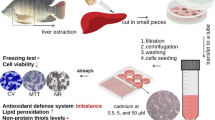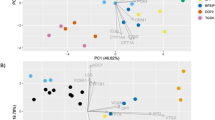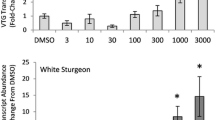Abstract
Graded doses of 2,3,7,8-tetrachlorodibenzo-p-dioxin (TCDD) were added to primary hepatocyte cultures of bald eagle (Haliaeetus leucocephalus) embryos to determine their sensitivity to induction of cytochrome P4501A (CYP1A) and porphyrin accumulation. No porphyrin accumulation was observed, but both CYP1A catalytic activity (using the ethoxyresorufin-O-deethylase (EROD) assay) and immunodetectable CYP1A were induced by relatively high concentrations of TCDD. Bald eagle hepatocytes were less sensitive to CYP1A induction than hepatocytes from any other avian species that we have studied to date. These in vitro results are in general agreement with recent assessments of field data, which indicate that bald eagles are relatively insensitive to some of the effects of TCDD and related compounds. Preparation of bald eagle hepatocytes was challenging because existing methods did not yield monolayers of cells. Here we describe details of a new method that was successful for bald eagle hepatocytes. This new method is used routinely in our laboratory to prepare hepatocyte cultures from birds for examination of various biochemical responses to environmental contaminants.
Similar content being viewed by others
References
Bosveld, A.T.C. (1995). Effects of polyhalogenated aromatic hydrocarbons on piscivorous avian wildlife, Ph. D. Dissertation, University of Utrecht, pp. 1-171.
Bowerman, W.W., Giesy, J.P., Best, D.A. and Kramer, V.J. (1995). A review of factors affecting productivity of bald eagles in the Great Lakes region: implications for recovery. Environ. Health Perspect. 103, 51-9.
Brunström, B. (1988). Sensitivity of embryos from duck, goose, herring gull, and various chicken breeds to 3.3′,4,4′-tetrachlorobiphenyl. Poult. Sci. 67, 52-7.
Brunström, B. and Lund, J. (1988). Differences between chick and turkey embryos in sensitivity to 3,3′4,4′-tetrachlorobiphenyl and in concentration/affinity of the hepatic receptor for 2,3,7,8-tetrachlorodibenzo-p-dioxin. Comp. Biochem. Physiol. 91C, 507-12.
Brunström, B. and Reutergårdh, L. (1986). Differences in sensitivity of some avian species to the embryotoxicity of a PCB, 3,3′4,4′-tetrachlorobiphenyl, injected into the eggs. Environ. Pollut. 42, 37-45.
Elliott, J.E. and Harris, M.L. (2001/2002). An ecotoxicological assessment of chlorininated hydrocarbon effects on bald eagle populations. Rev. Toxicol. 4, 1-60.
Elliott, J.E., Kennedy, S.W. and Lorenzen, A. (1997). Comparative toxicity of polychlorinated biphenyls to Japanese quail (Coturnix c. japonica) and American kestrels (Falco sparverius). J. Toxicol. Environ. Health 51, 57-75.
Elliott, J.E., Norstrom, R.J., Lorenzen, A., Hart, L.E., Philbert, H., Kennedy, S.W., Stegeman, J.J., Bellward, G.D. and Cheng, K.M. (1996). Biological effects of polychlorinated-p-dioxins, dibenzofurans, and biphenyls in bald eagle (Haliaeetus leucocephalus) chicks. Environ. Toxicol. Chem. 15, 782-93.
Fischer, P.W.F. and Marks, G.S. (1976). Chick embryo liver cells maintained in serum-free Waymouth MD 705/1 medium. Tiss. Cult. Assoc. Manual 2, 449-52.
Giesy, J.P., Bowerman, W.W., Mora, M.A., Verbrugge, D.A., Othoudt, R.A., Newsted, J.L., Summer, C.L., Aulerich, R.J., Bursian, S.J., Ludwig, J.P., Dawson, G.A., Kubiak, T.J., Best, D.A. and Tillitt, D.E. (1995). Contaminants in fishes from Great Lakes-influenced sections and above dams of three Michigan rivers: III. Implications for health of bald eagles. Arch. Environ. Contam. Toxicol. 29, 309-21.
Giesy, J.P., Ludwig, J.P. and Tillitt, D.E. (1994). Dioxins, dibenzofurans, PCBs and colonial fish-eating waterbirds. In A. Schecter (ed.) Dioxins and Health, pp. 249-307. New York: Plenum Press.
Gilday, D., Bellward, G.D., Sanderson, J.T., Janz, D.M. and Rifkind, A.B. (1998) 2,3,7,8-tetrachlorodibenzo-p-dioxin (TCDD) induces hepatic cytochrome P450-dependent arachidonic acid epoxidation in diverse avian orders: regioisomer selectivity and immunochemical comparison of the TCDD-induced P450s to CYP1A4 and 1A5. Toxicol. Appl. Pharmacol. 150, 106-16.
Hahn, M.E., Woodward, B.L., Stegeman, J.J. and Kennedy, S.W. (1996). Rapid assessment of induced cytochrome P4501A protein and catalytic activity in fish hepatoma cells grown in multiwell plates: response to TCDD, TCDF, and two planar PCBs. Environ. Toxicol. Chem. 15, 582-91.
Hestermann, E.V., Stegeman, J.J. and Hahn, M.E. (2000). Relative contributions of affinity and intrinsic efficacy to aryl hydrocarbon receptor ligand potency. Toxicol. Appl. Pharmacol. 168, 160-72.
Hoffman, D.J., Melancon, M.J., Klein, P.N., Eisemann, J.D. and Spann, J.W. (1998). Comparative developmental toxicity of planar polychlorinated biphenyl congeners in chickens, American kestrels and common terns. Environ. Toxicol. Chem. 17, 747-57.
Janz, D.M. and Bellward, G.D. (1996). In Ovo 2,3,7,8-tetrachlorodibenzo-p-dioxin exposure in three avian species. Toxicol. Appl. Pharmacol. 139, 292-300.
Kennedy, S.W., Fox, G.A., Trudeau, S., Bastien, L.J. and Jones, S.P. (1998). Highly carboxylated porphyrin concentration: a biochemical marker of PCB exposure in herring gulls. Mar. Environ. Res. 46, 65-9.
Kennedy, S.W., Jones, S.P. and Bastien, L.J. (1995). Efficient analysis of cytochrome P4501A catalytic activity, porphyrins, and total proteins in chicken embryo hepatocyte cultures with a fluorescence plate reader. Anal. Biochem. 226, 362-70.
Kennedy, S.W., Lorenzen, A., James, C.A. and Collins, B.T. (1993). Ethoxyresorufin-O-deethylase and porphyrin analysis in chicken embryo hepatocyte cultures with a fluorescence multiwell plate reader. Anal. Biochem. 211, 102-12.
Kennedy, S.W., Lorenzen, A., Jones, S.P., Hahn, M.E. and Stegeman, J.J. (1996). Cytochrome P4501A induction in avian hepatocyte cultures: a promising approach for predicting the senstivity of avian species to toxic effects of halogenated aromatic hydrocarbons. Toxicol. Appl. Pharmacol. 141, 214-30.
Kreamer, B.L., Staecker, J.L., Sawada, N., Sattler, G.L., Hsia, M.T.S. and Pitot, H.C. (1986). Use of a low-speed, isodensity Percoll centrifugation method to increase the viability of isolated rat hepatocyte preparations. In Vitro Cellular and Developmental Biol. 22, 201-11.
Lorenzen, A., Casley, W.L. and Moon, T.W. (2001). A reverse transcription-polymerase chain reaction bioassay for avian vitellogenin mRNA. Toxicol. Appl. Pharmacol. 176, 169-80.
Lorenzen, A., Kennedy, S.W., Bastien, L.J. and Hahn, M.E. (1997a). Halogenated aromatic hydrocarbon-mediated porphyrin accmulation and induction of cytochrome P4501A in chicken embryo hepatocytes. Biochem. Pharmacol. 53, 373-84.
Lorenzen, A., Shutt, L.J., Kennedy, S.W. (1997b). Sensitivity of common tern (Sterna hirundo) embryo hepatocyte cultures to CYP1A induction and porphyrin accumulation by halogenated aromatic hydrocarbons and common tern egg extracts. Arch. Environ. Contam. Toxicol. 32, 126-34.
Park, S.S., Miller, H., Klotz, A.V., Kloepper-Sams, P.J., Stegeman, J.J. and Gelboin, H.V. (1986). Monoclonal antibodies to liver microsomal cytochrome P-450E of the marine fish Stenotomus chrysops (scup): cross reactivity with 3-methylcholanthrene induced rat cytochrome P-450. Arch. Biochem. Biophys. 249, 339-50.
Petrulis, J.R. and Bunce, N.J. (1999). Competitive inhibition by inducer as a confounding factor in the use of the ethoxyresorufin-O-deethylase (EROD) assay to estimate exposure to dioxin-like compounds. Toxicol. Lett. 105, 251-60.
Rifkind, A.B., Kanetoshi, A., Orlinick, J., Capdevila, J.H. and Lee, C. (1994). Purification and biochemical characterization of two major cytochrome-P-450 isoforms induced by 2,3,7,8-tetrachlorodibenzo-p-dioxin in chick embryo liver. J. Biol. Chem. 269, 3387-96.
Sanderson, J.T. and Bellward, G.D. (1995). Hepatic microsomal ethoxyresorufin O-deethylase-inducing potency in ovo and cytosolic Ah receptor binding affinity of 2,3,7,8-tetrachlorodibenzo-p-dioxin: comparison of four avian species. Toxicol. Appl. Pharmacol. 132, 131-45.
Sanderson, J.T., Kennedy, S.W. and Giesy, J.P. (1998). In vitro induction of ethoxyresorufin-O-deethylase and porphyrins by halogenated aromatic hydrocarbons in avian primary hepatocytes. Environ. Toxicol. Chem. 17, 1323-31.
Stegeman, J.J. and Hahn, M.E. (1994). Biochemistry and molecular biology of monooxygenases: current perspectives on forms, functions, and regulation of cytochrome P450 in aquatic species. In D.C. Malins and G.K. Ostrander (eds) Aquatic Toxicology: Molecular, Biochemical, and Cellular Perspectives, pp. 87-206. Boca Raton: Lewis Publishers.
Steinberg, M.S. (1963). “ECM”: its nature, origin and function in cell aggregation. Exp. Cell Res. 30, 257-79.
Stevens, L. (1996). Avian Biochemistry and Molecular Biology, pp. 1-272. Cambridge: Cambridge University Press.
Villeneuve, D.L., Blankenship, A.L. and Giesy, J.P. (2000). Derivation and application of relative potency estimates based on in vitro bioassay results. Environ. Toxicol. Chem. 19, 2835-43.
Vos, J.G., Botterweg, P.F., Strik, J.J.T.W.A. and Koeman, J.H. (1972). Experimental studies with HCB in birds. TNO-nieuws 27, 599-603.
Woodford, J.E., Karasov, W.H., Meyer, M.W. and Chambers, L. (1998). Impact of 2,3,7,8-TCDD exposure on survival, growth, and behavior of ospreys breeding in Wisconsin, USA. Environ. Toxicol. Chem. 17, 1323-31.
Author information
Authors and Affiliations
Corresponding author
Rights and permissions
About this article
Cite this article
Kennedy, S.W., Jones, S.P. & Elliott, J.E. Sensitivity of Bald Eagle (Haliaeetus leucocephalus) Hepatocyte Cultures to Induction of Cytochrome P4501A by 2,3,7,8-Tetrachlorodibenzo-p-dioxin. Ecotoxicology 12, 163–170 (2003). https://doi.org/10.1023/A:1022546509053
Issue Date:
DOI: https://doi.org/10.1023/A:1022546509053




